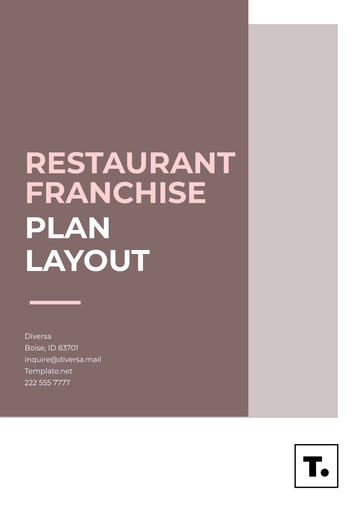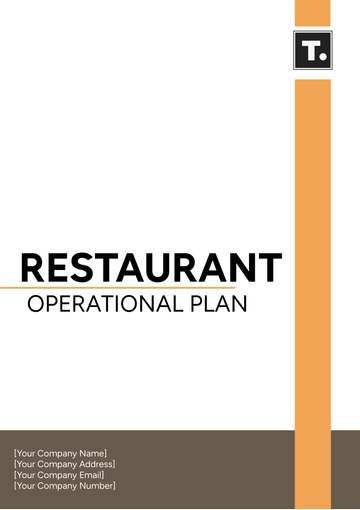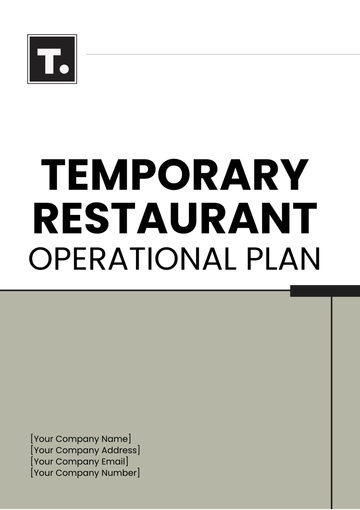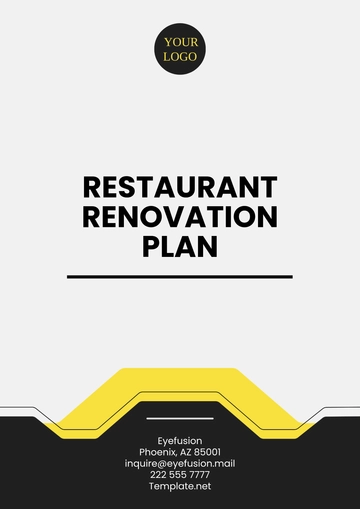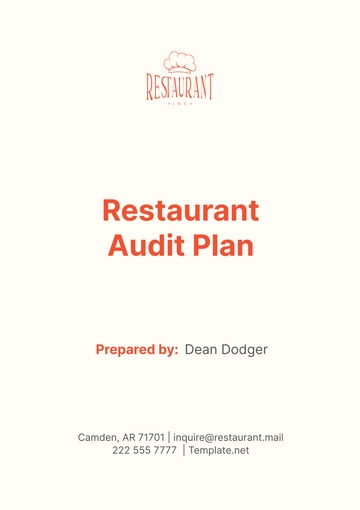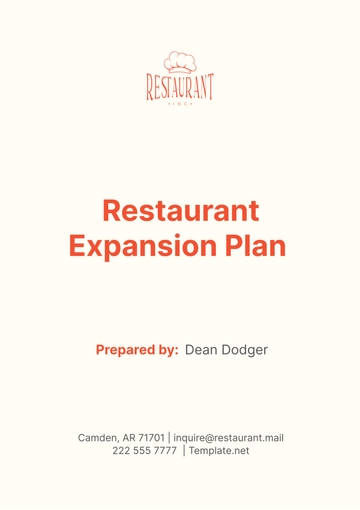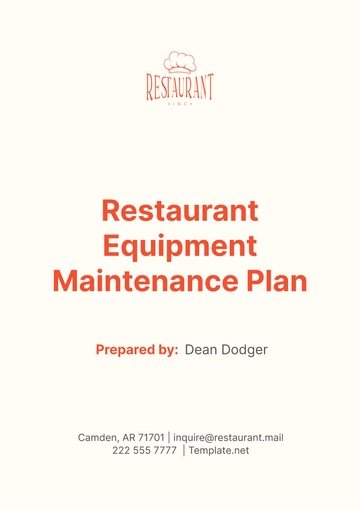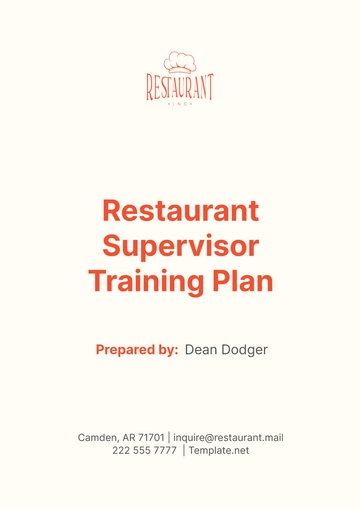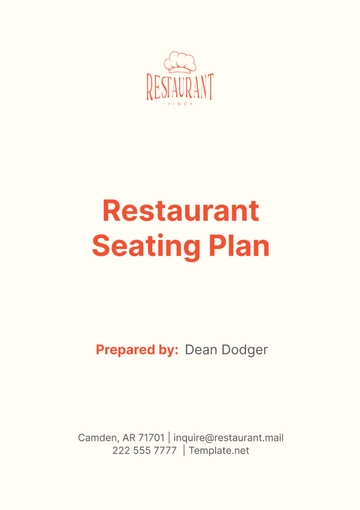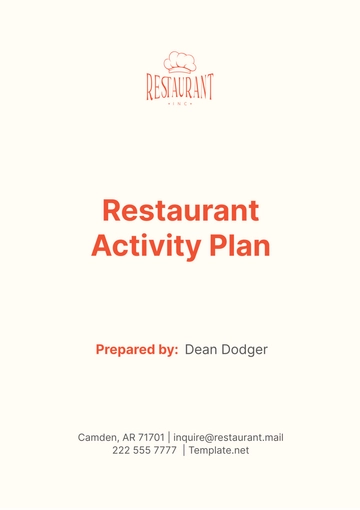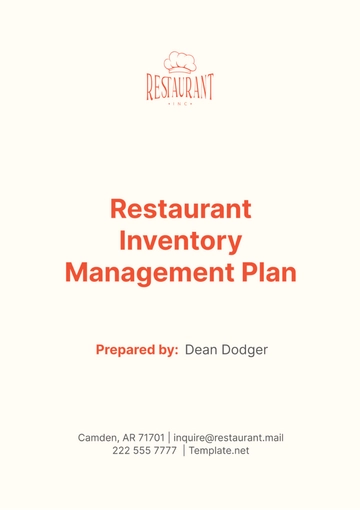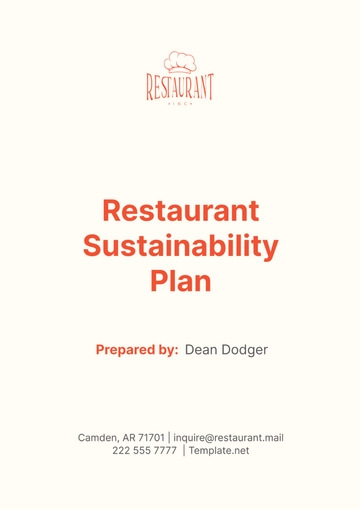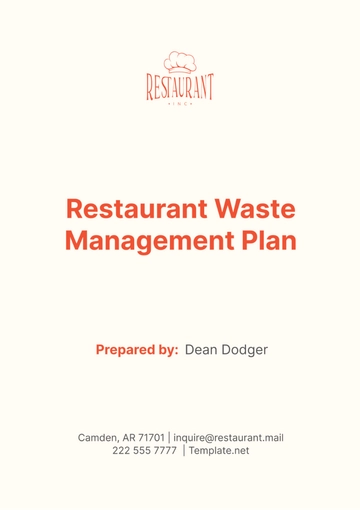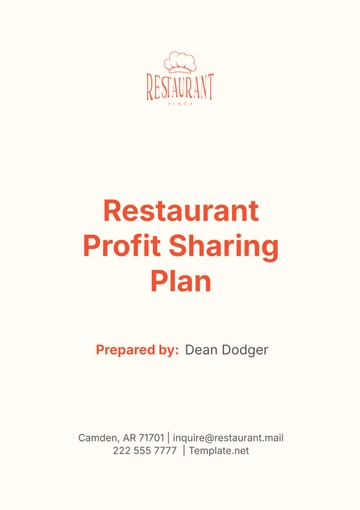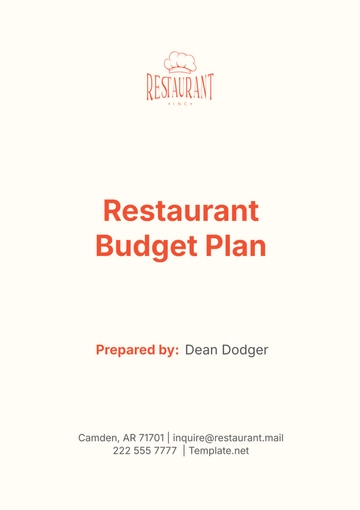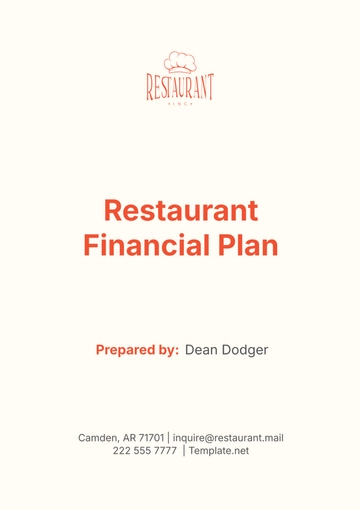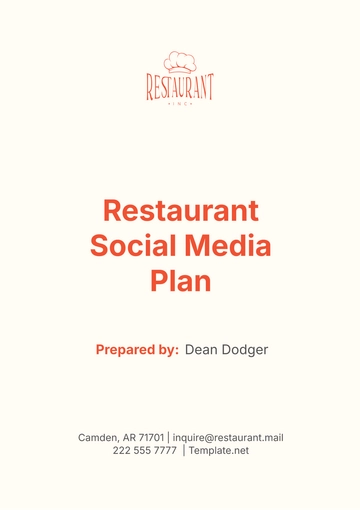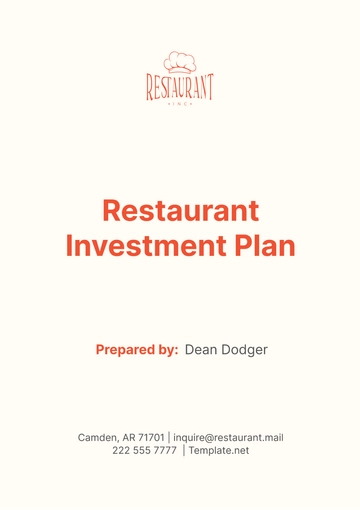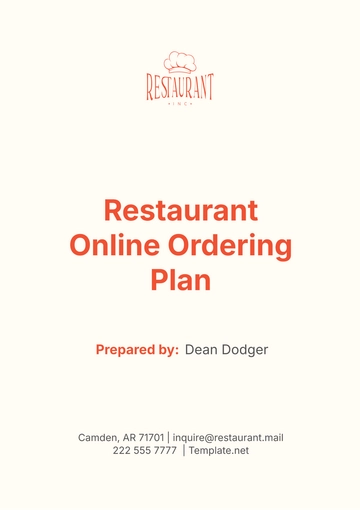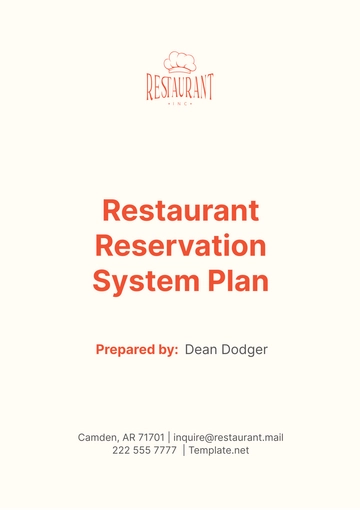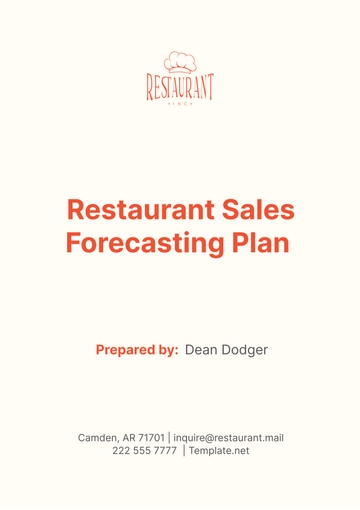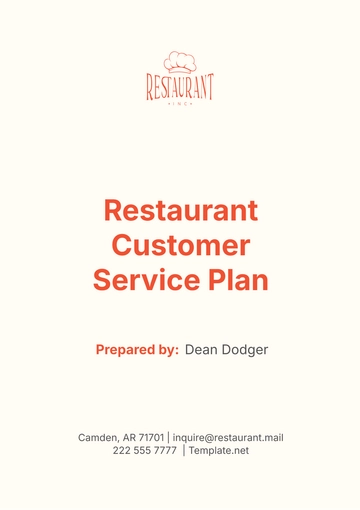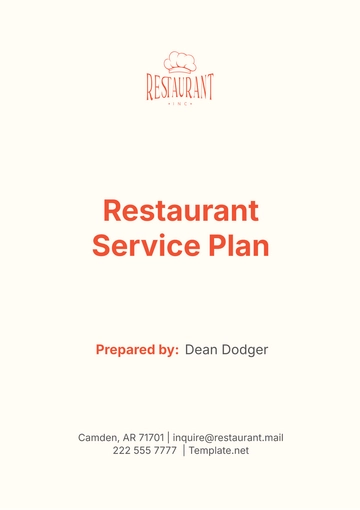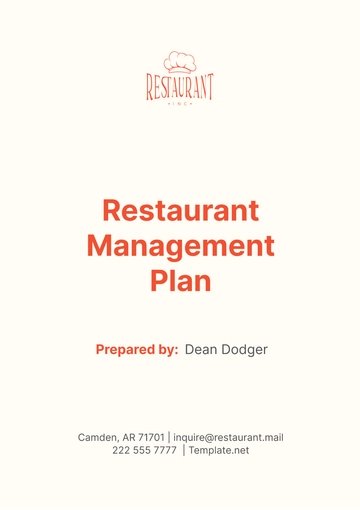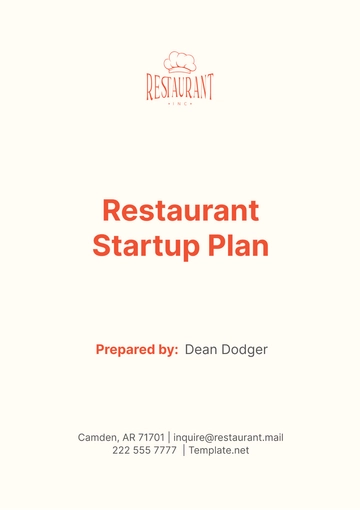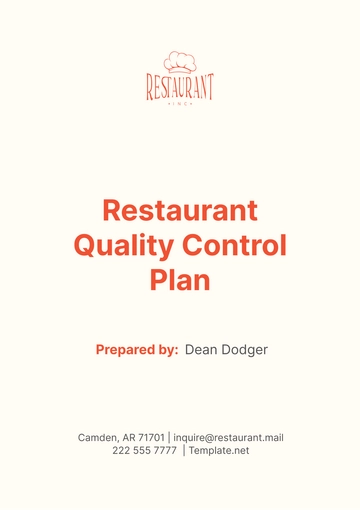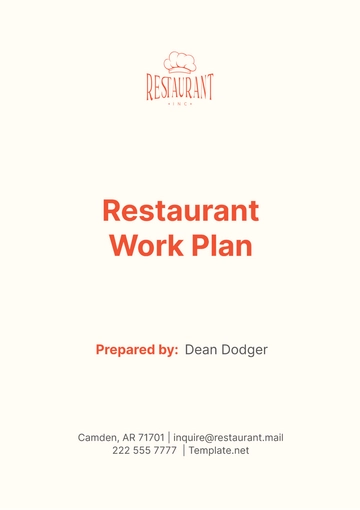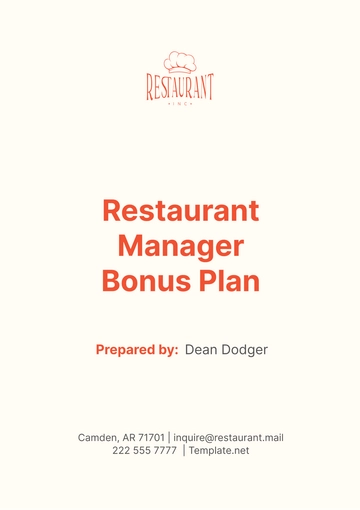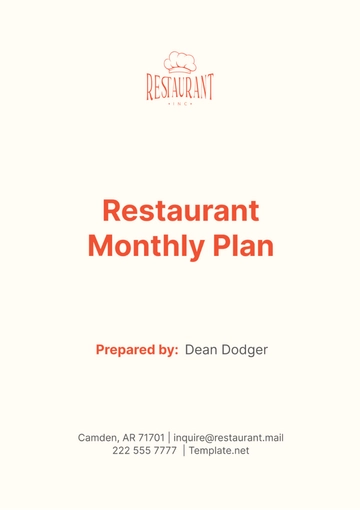Free Restaurant Budget Plan
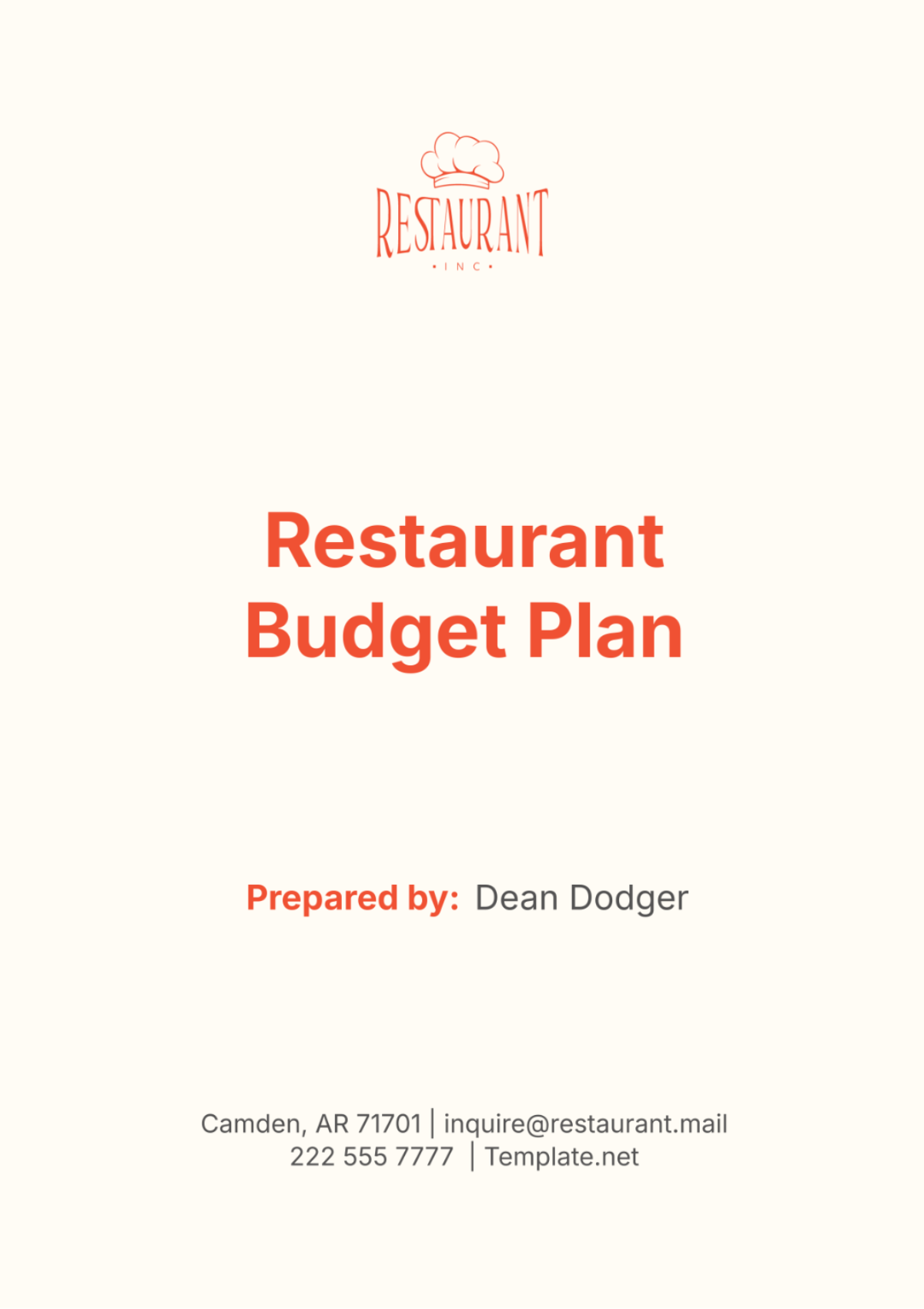
I. Executive Summary
The purpose of this budget plan is to provide a detailed financial roadmap for [Your Company Name] for the upcoming fiscal year. This comprehensive plan outlines projected income, expenses, and capital investments necessary to achieve our restaurant's operational and financial goals. By carefully managing resources and planning expenditures, we aim to enhance profitability, improve customer satisfaction, and ensure sustainable growth. This document will serve as a guide to maintain financial stability, optimize operational efficiency, and allocate resources effectively to support growth initiatives.
Our vision is to be a leading restaurant that offers an exceptional dining experience through high-quality food and outstanding service. The budget plan is a critical tool that will help us navigate financial challenges, seize growth opportunities, and ultimately achieve our business objectives.
II. Business Overview
[Your Company Name] is a full-service restaurant renowned for its continental cuisine, catering to a diverse clientele that includes families, tourists, and business executives. Our menu features a variety of dishes inspired by European, American, and other international flavors, ensuring there is something for everyone. Located in a prime area, our restaurant provides a welcoming atmosphere, excellent service, and high-quality meals, making it a preferred choice for both casual dining and special occasions.
Our target market includes:
Families: Offering a child-friendly menu and a comfortable dining environment that appeals to parents and children alike.
Tourists: Attracting visitors with our unique menu and convenient location near popular tourist destinations.
Business Executives: Providing a professional and upscale dining experience suitable for business meetings and corporate events.
By focusing on these key customer segments, we aim to build a loyal customer base and drive consistent revenue growth.
III. Budget Objectives
The primary objectives of this budget plan are to:
Ensure Financial Stability and Profitability: Maintain a healthy balance between income and expenses to achieve sustainable financial growth.
Optimize Operational Efficiency: Streamline operations to reduce costs and improve service delivery.
Allocate Resources Effectively: Invest in areas that will drive growth and enhance the customer experience.
Plan for Capital Expenditures: Identify and prioritize investments in infrastructure and technology to support long-term growth.
Maintain a Healthy Cash Flow: Ensure sufficient liquidity to meet operational needs and take advantage of new opportunities.
IV. Projected Income
A. Revenue Projections
Revenue projections are based on historical sales data, market trends, and planned marketing initiatives. We anticipate steady growth in sales, driven by our targeted marketing efforts and continued focus on providing a superior dining experience. The following table outlines the projected monthly revenue for the upcoming fiscal year:
Month | Projected Revenue ($) |
|---|---|
January | 55,000 |
February | 60,000 |
March | 65,000 |
April | 70,000 |
May | 75,000 |
June | 80,000 |
July | 85,000 |
August | 90,000 |
September | 80,000 |
October | 75,000 |
November | 70,000 |
December | 100,000 |
Total | 905,000 |
B. Revenue Sources
The primary sources of revenue for [Your Company Name] include:
Dine-in Sales: Revenue generated from customers dining at the restaurant.
Takeout and Delivery Sales: Revenue from orders placed for takeout or delivery.
Catering Services: Income from catering events such as weddings, corporate functions, and private parties.
Special Events: Revenue from hosting special events and private dining experiences.
V. Projected Expenses
A. Operating Expenses
Operating expenses are the costs required to run the day-to-day operations of the restaurant. We have categorized these expenses into fixed and variable costs to better understand their impact on our budget.
Fixed Costs
Fixed costs are those expenses that remain constant regardless of the restaurant's level of business activity. These include rent, insurance, and salaries for permanent staff. By keeping fixed costs under control, we can ensure that our restaurant remains financially stable even during periods of lower sales.
Variable Costs
Variable costs fluctuate based on the restaurant's level of business activity. These include costs for food and beverages, labor for hourly staff, and utilities. Managing variable costs effectively is crucial to maintaining healthy profit margins and ensuring that our restaurant operates efficiently.
The following table details the projected monthly operating expenses:
Expense Category | Monthly Cost ($) | Annual Cost ($) |
|---|---|---|
Food and Beverage | 25,000 | 300,000 |
Labor Costs | 20,000 | 240,000 |
Rent | 10,000 | 120,000 |
Utilities | 5,000 | 60,000 |
Marketing and Advertising | 3,000 | 36,000 |
Maintenance and Repairs | 2,000 | 24,000 |
Supplies | 1,500 | 18,000 |
Insurance | 1,000 | 12,000 |
Miscellaneous | 500 | 6,000 |
Total | 68,000 | 816,000 |
VI. Capital Expenditures
A. Planned Investments
Capital expenditures are investments in long-term assets that will help grow the business. These investments are necessary to maintain the restaurant's competitive edge, improve operational efficiency, and enhance the customer experience. The following table outlines the planned capital expenditures for the upcoming fiscal year:
Investment Category | Estimated Cost ($) |
|---|---|
Kitchen Equipment Upgrade | 50,000 |
Dining Area Renovation | 30,000 |
Technology Upgrades | 20,000 |
Marketing Initiatives | 10,000 |
Total | 110,000 |
B. Justification for Investments
Kitchen Equipment Upgrade: Upgrading kitchen equipment will improve efficiency, reduce food waste, and enhance the quality of dishes prepared.
Dining Area Renovation: Renovating the dining area will create a more inviting atmosphere, attracting more customers and increasing repeat business.
Technology Upgrades: Investing in technology such as point-of-sale systems and online ordering platforms will streamline operations and enhance the customer experience.
Marketing Initiatives: Allocating funds for marketing will increase brand awareness, attract new customers, and boost sales.
VII. Cash Flow Management
A. Cash Flow Projections
Effective cash flow management ensures that the restaurant can meet its financial obligations while investing in growth opportunities. The following table outlines the projected monthly cash flow:
Month | Cash Inflow ($) | Cash Outflow ($) | Net Cash Flow ($) |
|---|---|---|---|
January | 55,000 | 68,000 | -13,000 |
February | 60,000 | 68,000 | -8,000 |
March | 65,000 | 68,000 | -3,000 |
April | 70,000 | 68,000 | 2,000 |
May | 75,000 | 68,000 | 7,000 |
June | 80,000 | 68,000 | 12,000 |
July | 85,000 | 68,000 | 17,000 |
August | 90,000 | 68,000 | 22,000 |
September | 80,000 | 68,000 | 12,000 |
October | 75,000 | 68,000 | 7,000 |
November | 70,000 | 68,000 | 2,000 |
December | 100,000 | 68,000 | 32,000 |
Total | 905,000 | 816,000 | 89,000 |
B. Strategies for Managing Cash Flow
Monitor Cash Flow Regularly: Regularly review cash flow statements to ensure timely identification of potential issues.
Control Costs: Implement cost-control measures to reduce unnecessary expenses and improve profitability.
Increase Revenue: Focus on increasing sales through marketing initiatives, menu innovation, and exceptional customer service.
Maintain a Cash Reserve: Establish a cash reserve to cover unexpected expenses and fluctuations in revenue.
VIII. Financial Goals
A. Short-Term Goals
Increase Monthly Revenue: Aim to increase monthly revenue by 10% through targeted marketing campaigns and promotions.
Improve Profit Margins: Implement cost-saving measures to improve profit margins by 5%.
Enhance Customer Satisfaction: Focus on delivering exceptional dining experiences to boost customer satisfaction and repeat business.
B. Long-Term Goals
Expand Market Reach: Explore opportunities to expand the restaurant's market reach through new locations or additional services such as catering.
Sustain Financial Growth: Achieve consistent financial growth by optimizing operations and continuously improving the menu and services.
Build Brand Reputation: Strengthen the restaurant's brand reputation by maintaining high standards of quality and service.
IX. Risk Management
A. Identifying Potential Risks
Economic Downturn: Economic fluctuations can impact consumer spending and restaurant revenue.
Operational Risks: Risks related to food safety, equipment failure, and staff turnover.
Competitive Pressure: Increased competition from other restaurants and food service providers.
B. Mitigation Strategies
Diversify Revenue Streams: Diversify revenue streams by offering catering services, takeout, and delivery options.
Implement Safety Protocols: Ensure strict adherence to food safety and hygiene protocols to minimize operational risks.
Competitive Analysis: Regularly analyze competitors to stay ahead of market trends and adjust strategies accordingly.
X. Conclusion
A. Summary
This budget plan outlines the financial strategy for [Your Company Name] for the upcoming fiscal year, detailing projected income, expenses, and capital investments. By carefully managing resources, planning expenditures, and mitigating risks, the restaurant aims to achieve its financial goals and ensure sustainable growth.
B. Recommendations
To achieve the outlined objectives, it is recommended that [Your Company Name] focuses on increasing revenue through targeted marketing, controlling costs to improve profit margins, and investing in key areas such as kitchen equipment, dining area renovations, and technology upgrades. Regular monitoring of cash flow and proactive risk management will also be crucial to the restaurant's success.
C. Next Steps
The next steps involve implementing the strategies outlined in this budget plan, monitoring financial performance regularly, and making necessary adjustments to stay on track with the restaurant's financial goals. By adhering to this budget plan, [Your Company Name] can ensure a prosperous and financially stable future.
- 100% Customizable, free editor
- Access 1 Million+ Templates, photo’s & graphics
- Download or share as a template
- Click and replace photos, graphics, text, backgrounds
- Resize, crop, AI write & more
- Access advanced editor
Achieve financial mastery in your restaurant operations with Template.net's Restaurant Budget Plan Template. Seamlessly manage expenses, forecast revenue, and optimize spending to maximize profitability. Our AI editor tool empowers you to customize every aspect of the budget plan, ensuring it aligns perfectly with your restaurant's goals. Take control of your finances and pave the way for sustainable success.
You may also like
- Finance Plan
- Construction Plan
- Sales Plan
- Development Plan
- Career Plan
- Budget Plan
- HR Plan
- Education Plan
- Transition Plan
- Work Plan
- Training Plan
- Communication Plan
- Operation Plan
- Health And Safety Plan
- Strategy Plan
- Professional Development Plan
- Advertising Plan
- Risk Management Plan
- Restaurant Plan
- School Plan
- Nursing Home Patient Care Plan
- Nursing Care Plan
- Plan Event
- Startup Plan
- Social Media Plan
- Staffing Plan
- Annual Plan
- Content Plan
- Payment Plan
- Implementation Plan
- Hotel Plan
- Workout Plan
- Accounting Plan
- Campaign Plan
- Essay Plan
- 30 60 90 Day Plan
- Research Plan
- Recruitment Plan
- 90 Day Plan
- Quarterly Plan
- Emergency Plan
- 5 Year Plan
- Gym Plan
- Personal Plan
- IT and Software Plan
- Treatment Plan
- Real Estate Plan
- Law Firm Plan
- Healthcare Plan
- Improvement Plan
- Media Plan
- 5 Year Business Plan
- Learning Plan
- Marketing Campaign Plan
- Travel Agency Plan
- Cleaning Services Plan
- Interior Design Plan
- Performance Plan
- PR Plan
- Birth Plan
- Life Plan
- SEO Plan
- Disaster Recovery Plan
- Continuity Plan
- Launch Plan
- Legal Plan
- Behavior Plan
- Performance Improvement Plan
- Salon Plan
- Security Plan
- Security Management Plan
- Employee Development Plan
- Quality Plan
- Service Improvement Plan
- Growth Plan
- Incident Response Plan
- Basketball Plan
- Emergency Action Plan
- Product Launch Plan
- Spa Plan
- Employee Training Plan
- Data Analysis Plan
- Employee Action Plan
- Territory Plan
- Audit Plan
- Classroom Plan
- Activity Plan
- Parenting Plan
- Care Plan
- Project Execution Plan
- Exercise Plan
- Internship Plan
- Software Development Plan
- Continuous Improvement Plan
- Leave Plan
- 90 Day Sales Plan
- Advertising Agency Plan
- Employee Transition Plan
- Smart Action Plan
- Workplace Safety Plan
- Behavior Change Plan
- Contingency Plan
- Continuity of Operations Plan
- Health Plan
- Quality Control Plan
- Self Plan
- Sports Development Plan
- Change Management Plan
- Ecommerce Plan
- Personal Financial Plan
- Process Improvement Plan
- 30-60-90 Day Sales Plan
- Crisis Management Plan
- Engagement Plan
- Execution Plan
- Pandemic Plan
- Quality Assurance Plan
- Service Continuity Plan
- Agile Project Plan
- Fundraising Plan
- Job Transition Plan
- Asset Maintenance Plan
- Maintenance Plan
- Software Test Plan
- Staff Training and Development Plan
- 3 Year Plan
- Brand Activation Plan
- Release Plan
- Resource Plan
- Risk Mitigation Plan
- Teacher Plan
- 30 60 90 Day Plan for New Manager
- Food Safety Plan
- Food Truck Plan
- Hiring Plan
- Quality Management Plan
- Wellness Plan
- Behavior Intervention Plan
- Bonus Plan
- Investment Plan
- Maternity Leave Plan
- Pandemic Response Plan
- Succession Planning
- Coaching Plan
- Configuration Management Plan
- Remote Work Plan
- Self Care Plan
- Teaching Plan
- 100-Day Plan
- HACCP Plan
- Student Plan
- Sustainability Plan
- 30 60 90 Day Plan for Interview
- Access Plan
- Site Specific Safety Plan
